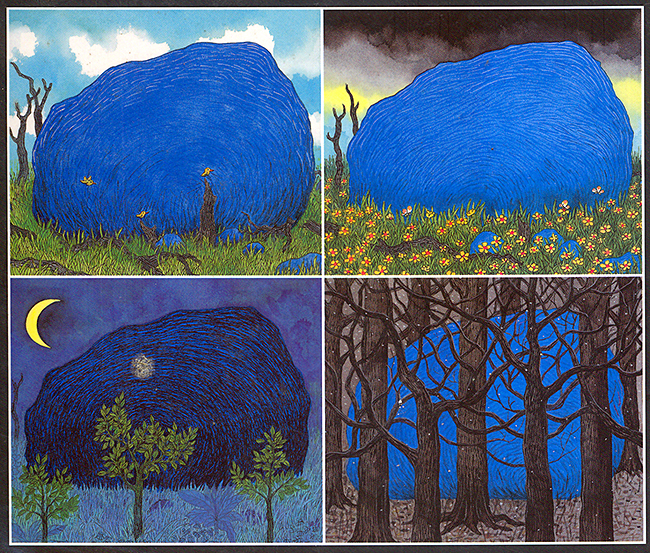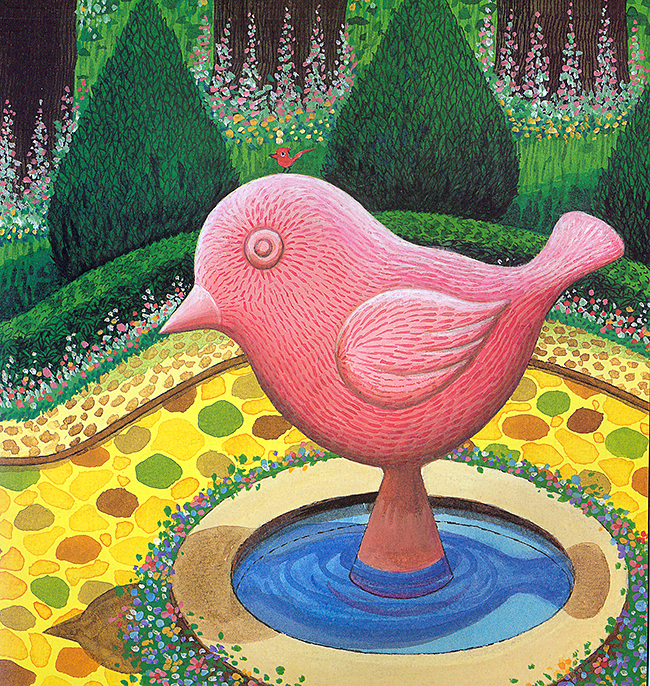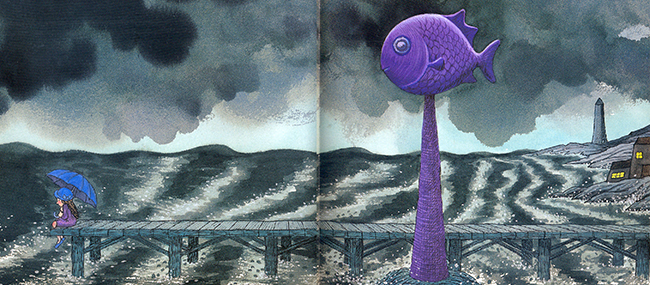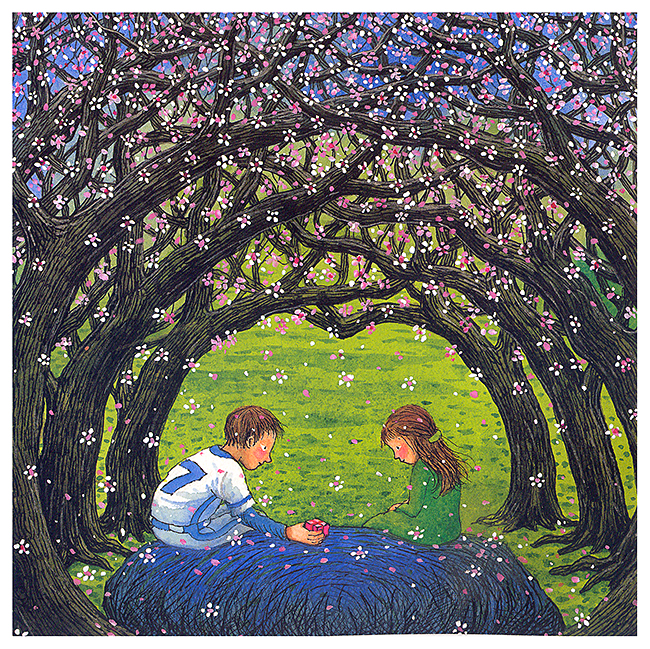
Jimmy Liao (廖福彬) is a well-known Taiwanese illustrator and writer. His illustrated books, written for adults and teens, are full of the whimsical, colourful drawings you would expect to find in a storybook for children, but his bittersweet stories tend to involve deeper themes like loneliness, longing, fate and hopefulness and are open to very different interpretations.
He goes by the pen name 幾米 a phonetic translation of his English name (Jimmy). He began his career in advertising but after a harsh three-year battle with leukemia, In an interview with Paper Tigers (papertigers.org/gallery/Jimmy_Liao/: offline), he speaks of how this battle helped to shape his artistic vision
“Looking back at that time, I’d say the leukemia did have a huge effect on my creativity. My painting started to show a different sense: slight sadness, a feeling of alienation, and a sense of helplessness revealed through the joyful pictures. Many people told me that I had made a great improvement. I didn’t quite believe it. But now I have gradually come to realize that, in fact, I was able to release some real emotion in each book I drew at that time, and that therefore part of my personal style was established through that experience”
Warning 1. Spoilers EVERYWHERE
Warning 2. I am working with the English translation of the book, which has been simplified. The translator was told by her publisher to “take these Taiwanese books for adults and turn them into English books for children.” (papertigers.org/personalViews/archiveViews/SThomson.html: offline)
1. Introduction
In the story The Blue Stone (藍石), the stone of the title exists peacefully in a forest for thousands of years. One day, however, it is split into two and one part is removed from its devastated forest home, brought into the human world and repeatedly carved to suit the whim of its human owners. In different guises—as a statue, a pendant, a simple rock—it witnesses a series of losses: a lost child, the death of an old woman, the disappearance of a husband at sea, a loss of freedom and the end of a first love. With each loss, with each reminder of the pain of existence, it recalls and longs to return to its own home in the forest. And with each reminder, the stone breaks a little until nothing is left but dust. The dust is then carried by the wind back to the forest where it can again find peace.

If the story is to be interpreted literally as simply the imagined life of an object, is there much meaning to be found? What would the themes be—objects don’t care much about people, objects desire to return to their natural state, things happen to people?
If the journey of the stone represents, as implied in the full title of the story “The Blue Stone: A Journey Though Life”, something about life, it is a very bleak journey indeed. We are born, pulled unwillingly into the world, experience a series of losses, confront the pain of existence, crumble bit by bit and then die, returning to wherever it is that we came from.
Is this really all there is to life’s journey—we are born, we suffer, we crumble, we die? For the longest time, I couldn’t really come up with a good interpretation of the story. Surely there must be more to life than this. After a conversation with a couple of my students, it finally dawned on me. The story of the blue stone is a cautionary tale. It doesn’t represent how life IS or how it SHOULD BE; it shows how life CAN BE if we obsess over trying to reclaim something we lost, if we obsess over trying to go back to an ideal time—a time of innocence, a time of wholeness, a time when everything was OK. The story shows what can happen if we let ourselves get lost in regret, sadness, longing and heartache and fail to appreciate the beauty around us.
2. The Guises of the Blue Stone and its Failure
The stone goes through several different guises. Each time it breaks a little and the main part is reshaped into something else.
- It is a stone in a forest. This is its original, whole state.
- It becomes a statue of an elephant, a symbol of strength, but it is fragile. Simply longing for its home causes it to break.
- It becomes a statue of a bird, a symbol of flight and freedom, yet weighed down with longing, it is too heavy to fly. It cannot even move.
- It becomes a statue of a fish, a symbol of abundance, yet whenever it is near an abundance of love, care or joy, it sees only emptiness and absence and feels only loneliness and longing.
- It becomes a sculpture of the moon, a symbol of dreams and ambition, yet it only looks back, longing to return to its lost home.
- It becomes a toy cat, a symbol of companionship and care. It was carved into something to be loved and to bring comfort, yet it seems unable to care.
- It becomes a brick, a symbol of creation and building, but it exists in a wall in a jail that imprisons dreams.
- It becomes a ball twirling through the air, a symbol of innocent joy, but it remains oblivious to the joy it brings others.
- It becomes a heart, a symbol of love, but it only feels its own longing and loneliness.
The different guises of the blue stone can represent its potential—to be strong, to be free, to enjoy the abundant beauty of the world, to dream and move forward, to care for and be cared for, to build and create, to bring joy, to love and be loved. There is purpose to its existence. However, throughout its life journey, the blue stone ignores its potential and instead always focuses on what it has lost—its tranquil forest home and its other half. It exists in a state of longing for an irrecoverable past. Its potential remains unfulfilled.
3. The Journey of Life
Let’s look at the different stages in the stone’s journey.
3.1 The Stone in the Forest
We can take the blue stone as representing one’s soul or spirit. At the beginning of the story, the blue stone “lies peacefully in the heart of the forest” for thousands of years. It is discovered by people who split it into two and one half is transported to civilization. In a sense, this represents a kind of birth. At birth, one is unknowingly pulled into the world from the womb and the physical connection to one’s mother—the umbilical cord—is severed. The splitting of the stone can also represent a loss of innocence. When innocent, one’s spirit is pure, whole and natural like the stone resting in the tranquil forest. Both events, birth and loss of innocence can be taken as starting points in life’s journey.
As soon as the stone begins its journey, however, “It longs for its other half. It wants to go home.”
But where is the forest home it is longing for? In the picture showing the stone being split and pulled apart, it is clear that the entire forest had been decimated. The stone is longing for something—a home—that no longer exists.
And what is the other half it is longing for? Every time the stone breaks, it appears that its consciousness remains with the largest part. There is no indication that the other parts are alive in any sense. The stone is not longing for a partner or for something like itself. It is simply longing to be whole again.
When we are born, we cannot return to the womb. And innocence, once lost, cannot be reclaimed. There is no going back. It is sensible to forever long for a time of innocence, for a time when everything was pure and natural, for a time when we were whole?
3.2 The Elephant
After being taken away, the stone is carved by a sculptor into a statue of an elephant that delights all who see it. The stone, however, seems oblivious to the joy it brings. One night, a lost child wanders by and asks the statue, “Can you tell me the way home?” The stone, confronted with this lost child—a symbol of lost innocence—starts to think of its own loss. It recalls the forest and longs to return home—to a place that no longer exists and to a time that has passed. “Its heart breaks a little” and it begins to crumble.
This is a recurring process in the book. The stone in transformed into something with a purpose, usually something that delights others, yet the stone itself remains oblivious to its purpose, ignores what it is capable of and focuses solely on its own sense of loss. Lost in melancholic regret and longing, the stone breaks apart piece by piece.
3.3 The Bird
The remains of the statue are used to create another sculpture—that of a bird. This statue resides in the garden of an old lady who every day “hobbles out to smell the flowers” and talk to the statue. The statue provides her with a kind of companionship, but this relationship does not seem to be acknowledged by the stone.

Years pass and the old lady no longer comes to the garden, presumably because she has passed away.
When we lose our innocence, we tend to lose it little by little. One step in a loss of innocence is when we are first confronted by the death of someone we know—quite often an elderly person like a grandparent. We begin to understand that life is temporary. We begin to understand our own mortality. Nothing lasts forever.
3.4 The Fish
When the statue is found by the old woman’s grandson, it is already broken. The grandson carves the remains of the blue stone into a statue of a fish. Every day in this guise, the stone watches a young man sail out to see and return, welcomed by his sweetheart. One stormy day, the man does not return. He is lost at sea. His girlfriend waits in vain at the dock while waves “smash against the reef and the cold wind blows”. This can represent another step in the loss of innocence. It is one thing to come to understand that all living things will one day grow old and die; it is another thing to understand that fate is capricious. One doesn’t have to be old to die. Death can come at any time.
And quite often there is nothing we can do about it. Though the stone is shaped in the form of the fish, it can’t swim. There is nothing it could have done to save the young man.

Confronted with the girls’ loss of her sweetheart—another reminder of the pain of existence—the stone recalls its forest home and longs to return.
However, once innocence is lost, there is no going back; once you understand the temporary nature of life and its innate fragility of life, you can never undo that knowledge.

3.5 The Moon
The remnants of the statue of the fish are found by divers who fashion it into something new–a golden statue of the moon. The moon can be considered a symbol of dreams and aspirations that are beautiful and enchanting, but perhaps just of of reach. In its guise as a statue of the moon, the blue stone warms the hearts of those who see it. It brings joy into the world (much as it did when it was a statue of an elephant), but remains oblivious to the happiness it brings. It senses only its own loss. The stone continues yearning for its former forest home and breaks again.
3.6 The Cat
It is found by a group of orphans who ask a man to carve it into something new, something they can love. It is turned into a statue of a cat and is used to decorate an orphanage. Another stage in the loss of innocence is the understanding that the world is not always fair. Why should one child have a warm and loving family and another have no family at all?
The children and the blue stone together gaze out of the window “longing for a home they cannot see.” The children will likely never be reunited with the birth families, so the home they are longing for is somewhere else, anywhere they can belong. The home the children cannot see belongs to the future, and they will likely find their home one day. The home the blue stone cannot see, in contrast, is one from the past, one that is already gone.
On the pages where everyone is “longing for a home”, eight children are shown in the windows. In the next two pages, the statue of the cat is show alone in a large empty room staring out of the window at the candlelight glowing from each house. It appears that most of the children have moved on to be with new families, but the blue stone remains.
The orphanage will never be empty of children. There will be other children who can gain some small solace from the lovely statue of the cat. The blue stone has a meaningful purpose, but does not seem aware of this. It remains oblivious to the small comfort it can bring and. longing for its lost home, it breaks again.
3.7 The Brick in the Wall
It is then found by prisoners who carry rocks to build their own jail and is used as a brick in the wall of a prison cell. This prison can represent another stage in the loss of innocence: the realization that we are not totally free to do whatever we want. At first, we must meet the demands of our parents, teachers and friends. Later on we need to meet the demands of our employers and families. There are responsibilities and obligations which, if we aren’t careful, can imprison us. In the drawings of the prison, no jailers are depicted and no one is shown telling the prisoners to build the jail. They seem to be doing that of their own free will. To a certain extent, we also give up our own freedoms and dreams willingly. We may put aside “unrealistic” dreams and study hard to get into university to take a suitable programme to get a degree to get a good job to have a good life. In essence, we may end up building the prison that restrains our own dreams.
In the prison, every day a young woman weeps , perhaps due to frustration and regret at losing her freedom. Her grey cell can represent the daily grind of study and work that can consume our dreams. Every night, when she has a little time to herself, her dreams come alive a little and she sings, bringing the walls of her prison alive with color.
The stone, now used as one of the rocks in the prison wall, once again is reminded of loss—this time the loss of freedom, the loss of dreams—and longs for its own lost home. It breaks once again The young woman dreams of “slipping through the bars and flying free on the wind,” but she remains in the prison which she built herself. She does however toss the fragment of the blue stone out of the window as a gesture of her desire to be free.
3.8 The Juggling Ball
The stone is picked up by a clown in travelling circus. Now quite small, the stone is carved into a juggling ball. It is used in a performance that amuses and delights people. Once again, it is able to bring people joy, but once again the stone remains oblivious to the happiness it helps to bring and just feels its own sense of loss. It breaks in mid-air during one performance.
The circus can represent another stage in the loss of innocence—the realization that a certain amount of performance is required to get through life. We cannot always show our true face; we cannot always say what we really think. We learn to entertain and amuse. We learn to dress up and put on a show. We learn to jump through hoops to please people so that we can get what we want. We learn to juggle a dozen tasks at once. We learn to walk the tightrope between who we really are and what everyone wants us to be. We learn to perform. Life is not a stage; it is a circus ring.
When the stone breaks, the clown “carelessly.tosses the broken stone away.” The use of the word ‘carelessly’ is important. Why should one be careful with a broken object? The use of the word carelessly here reveals that although the stone is now but a tiny fragment, it’s essence still exists within that small piece and therefore that fragment is still of value. At his point, it is still not too late for the stone to change.
3.9 The Heart Pendant
The remains of the heart pendant are found by a dog, which brings it to a young boy, who carves and polishes the stone into a heart pendant which he gives to a girl–his first love. “The lonely blue stone lies over a heart warm with love,” but the love the stone witnesses only serves to remind it of its own loneliness, and once again it breaks a little. This is more obvious in the original Chinese passage, which could be literally translated as “The world becomes a beautiful flowery room, and the spring blossoms carpet the whole valley. Blue stone lies close to the young girl’s bosom, like a truly blissful heart. She has everything, but it has nothing.”

“And since first love rarely lasts, the girl’s heart breaks as well.” She throws the pendant away and it falls onto the railway tracks, where it is eventually ground into dust by the passing trains,
Falling in love and then losing that love are also stages in the loss of innocence. With first love, often come words such as “I’ll love you forever” or “We be together forever”, but we soon find that ‘forever’ doesn’t last nearly as long as we thought it would. Like life itself, love is also impermanent and fragile.
The girl, heartbroken and focusing on her own loss rather than fondly remembering the love that once existed, throws the pendant onto the railway tracks. The stone remains there and each passing train—like the dull, soul-grinding routine of each passing day—splits the small stone until only a few grains of sand are left
3.10 The Return Home
Now reduced to dust, the stone is carried by the wind back to the forest. The picture of the forest at the end of the story mirrors that at the beginning, but there is one key difference–a blue glow can be seen in one area of the forest at the beginning. At the end, there is just green forest. The energy emanated by the stone is gone. Its journey is over. Ashes to ashes and dust to dust.
4. Conclusion
By losing itself in longing, sadness and regret, the stone ignores its own value and its own potential. The stone itself has a positive effect on almost all who come into contact with it.
It delights visitors and audience members in its guises as an elephant, star and ball.
It provides companionship for the old lady and the children in the orphanage and is loved by them.
It shares in the love between the boy and the girl and between the young lady and the fisherman.
Throughout its journey, the blue stone is surrounded by love, care, warmth and joy, but the stone remains oblivious to all these and gets lost in its own loneliness and longing.
And what about the love, care, warmth and joy that the stone experienced or witnessed? All things come to an end, so none of these experiences can last forever, but that is not the point. The point is that they did exist and the blue stone was a part of them. Yet, the stone only seems to recognize the loss of these things because those losses resonate with its own sense of loss. It experienced so much of life, but the blue stone was unable to truly share in and treasure those wonderful moments of love, care and joy that were all around it. Consequently, it crumbles, its spirit diminished piece by piece until there is nothing left but dust.
It is an easy trap to fall into. When a relationship breaks apart, when someone we love leaves us, when we lose our innocence, isn’t it easier to feel the sharp pangs of heartbreak and loss than it is to treasure the wonderful moments that did exist for that short time? To dwell on those sad moments and to forever long for things long past is to miss the abundance of joy we can find on our own journey of life. The story of the blue stone, therefore, is the story of a life that is rich in experience but which is emotionally unfulfilled and spiritually empty. It is a story of lost potential.
Can we fulfill the potential of our own life? Can we truly appreciate all that life offers us—all the pain and joy, all the loss and love. And can we appreciate all that our life can give to others? Can we truly live?
~by longzijun
January 2015
Return to Writing


oh i m so happy to see a new post from u
always bin looking to posts frm u. this one’s bin after a long time.